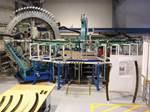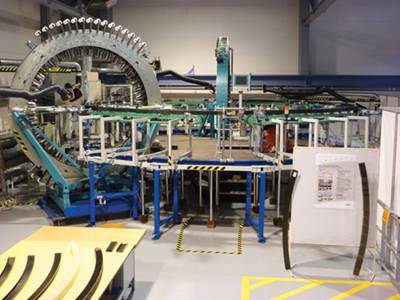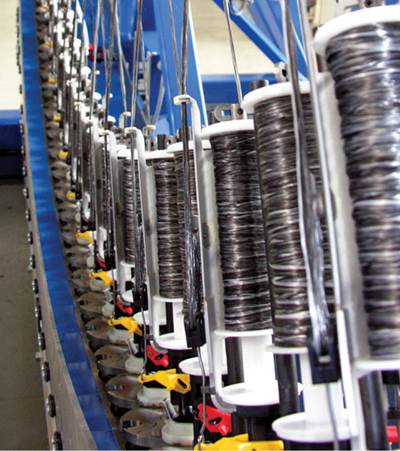An impec-able bike frame: Handmade by machine
Long on technology firsts, this optimized, automated manufacturing process produces nothing short of the “perfect” bike frame.
Based in Grenchen, Switzerland, home to world-class watchmakers Rolex and Breitling, Bicycle Manufacturing Co. (BMC) has likewise become an icon of Swiss engineering, precision and style. BMC’s racing team, led by Cadel Evans — the 2009 world champion and 2011 Tour de France winner on a BMC bike — is a Who’s Who of the sport, including Thor Hushovd, George Hincapie, Philippe Gilbert, Tejay van Garderen and Taylor Phinney. “We simply want to build the fastest and best bikes in the world,” says BMC owner Andy Rihs. “And, to ensure we are living up to this goal, we work with the best riders in the world.”
Now BMC leads cycling with its production of a 100 percent carbon fiber frame with a uniquely high level of automation and process control: the impec. Short for “impeccable,” the frame is the result of Rihs’ conviction that the industry practice of building frames in Asia using hand-layed prepreg permits neither full exploitation of carbon fiber’s benefits nor sufficient process control and precision. BMC spent more than €40 million ($51.8 million USD) and four years developing the materials, robotic processes and entirely new factory that were necessary to back the claim made on one of its factory billboards, “We built a Swiss factory to produce the perfect carbon bike.”
Beginning with engineering
BMC already had a track record of engineering innovation. Its Advanced Pivot System (APS) is billed as the “ideal” rear-wheel mountain bike suspension (see illustration in Fig. 1), able to deliver the “perfect” combination of efficiency, power and comfort.
Another engineering hallmark is BMC’s Tuned Compliance Concept (TCC), which uses a precise combination of different carbon fibers and orientations, along with stepped frame tube profiles, to provide increased flexibility in vertical components (frame, fork and seatpost) yet maintain high lateral and torsional rigidity. This improves handling and increases comfort and power transmission, slowing the onset of rider fatigue.
The perfect racing bike frame, however, would transform all of its rider’s pedal-turning energy directly into propulsion with no negative impact from its own weight. In pursuit of that goal, BMC’s impec engineers redesigned each frame tube to optimally perform its unique function in the frame, absorbing and distributing its individual stresses across its entire length, by tailoring both the shape of the tube and the architecture of the composite materials. It turns out that the perfect frame tube is hardly ever round. And, says plant manager Martin Kaenzig, “We also knew we wanted seamless tubes.”
Tuning the tubes
The solution was BMC’s Load Specific Weave (LSW) process. This three-stage, robot-controlled production line combines braiding, resin transfer molding (RTM) and trimming into a continuous process. Automated, computer-controlled braiding enables quick and accurate fiber placement and orientation. Moreover, it can negotiate changes in the cross section of the tube and provide seamless transitions along the tube between fiber patterns that are optimized for local stiffness and those that are optimized for overall torsional rigidity (see Fig. 1 and check out “Next-generation braiding for next-gen bike," at end of this article or under "Editor's Picks,” at top right).
Tube production begins with a mandrel, referred to by BMC as the “soul.” Previously aluminum, it is now a glass-fiber composite. “The soul,” says Kaenzig, “is the skeletal center of the mandrel. It does not have any geometry features.” The tube’s geometry is, instead, shaped into a silicone overlay that BMC calls the “core.” As will be made clear, the two-stage construction permits easy mandrel extraction. And because the resin won’t adhere to silicone, the core provides its own mold release, saving a process step.
The soul/core is fitted into a workpiece carrier that will enable mandrel transport, by means of specialized industrial robots, through computer-controlled and individually sealed braiding, molding, trimming, painting and assembly work cells, which are separated by automated guillotine doors. Each carrier contains a digital tag with its identification number and programs that activate and control each machine as it moves through the process stages. The computerized system also commands the handling robots and records relevant data for each workpiece. Thus, each tube is made-to-measure per specification, with accuracy verified within 0.1 mm (4 mils).
As processing begins, a robotic arm removes the workpiece carrier from the production line’s shuttle and feeds it into a radial braiding machine made by August Herzog Maschinenfabrik GmbH & Co. KG (Oldenburg, Germany). The data matrix for the part is read from the workpiece digital tag, and the braider draws carbon fiber tow supplied by Toho Tenax Europe GmbH (Wuppertal, Germany) from more than 100 bobbins as it begins weaving it along sinusoidal paths to produce a seamless braided tube or sleeve on the mandrel. The mandrel shape and rate of advance in the radial braider determines the density and arrangement of the carbon tows. When the braid is complete, robots cut the sleeve free, withdraw the workpiece carrier from the braider and replace it in the shuttle, which then proceeds to the RTM cell.
BMC claims theirs is the first fully automated composites RTM station in the world. A robotic arm transfers and locates the braided sleeve into a corresponding female matched metal mold, which is made from hot-formed steel. A special two-component nano-toughened epoxy resin is injected — injection time averages about four minutes — and the workpiece cures inmold in ~30 minutes at 80°C/176°F. Then the cured tube is demolded and placed back in the shuttle.
In the third production stage, also the final step in the LSW process, the tube is moved into the trim cell and cut to length. A 6-axis robotic arm transfers the workpiece from the shuttle to a holding fixture, where the soul is removed from the core. Then, the flexible silicone core can be retracted from the part. Next, the now hollow carbon tube is positioned via robot within a cutting cell that self-seals to contain carbon dust. After a precision diamond saw trims the tube to final size, it is removed from the cell and placed in a bin. A worker collects the binned tubes and performs a series of quality-assurance tests before depositing them at the assembly station.
Making precise connections
Having mastered the process for “perfect” tubes, the next question was how best to connect them. BMC calls its answer, the Shell Node Concept (SNC), “revolutionary” because it forms the frame’s nodal points not as one-piece collars, but instead as two bonded half shells. Each half shell’s inner and outer geometries, therefore, are more easily designed to optimize frame loading, and the shell’s ribbed interior (see Step 5) defines how the adjoined tubes fit with absolute precision. The shells are injection molded using a 40 percent carbon fiber/thermoplastic compound (by weight), with fibers ~4 mm/~0.2 inch in length. The combination of the stiff fibers and resilient matrix make the shells rigid and light yet shock absorbent.
Engineers defined the fiber orientation in each shell, using a CAD-based mold flow analysis simulation. The data was used to construct small batches of matched-metal tools. To verify the mold flow analysis results, these tools were subjected to a series of tests, including computed tomography, which accurately gauged the wall thickness and inspected the structure for faults. After necessary changes were made, the final metal tools were ready for injection.
Injection molding of shells is carried out offsite by a partner company that specializes in the process. The injection molding machine is equipped with the mold of the given shell, and an engineer loads in carbon compound pellets supplied by EMS Grivory (a business unit of EMS-Chemie AG, Domat/Ems, Switzerland). The machine melts and injects the compound. The finalized CAD data for the specific metal tool enable engineers to visually monitor the formation of the shell’s interior ridges and to control all of the key process parameters (temperature, fill time, flow rate and flow properties). During the molding cycle, these and other data are recorded, enabling further optimization. Molding is completed in minutes, after which the shells are deflashed and inspected.
Back at BMC, the shell halves are hand-placed into an adhesive application fixture (green fixture shown in Step 6) that has been mounted onto a carrier. Then they enter an automated workstation, where a robot equipped with an optical monitoring system recognizes each component and defines the quantity and location of adhesive before applying it to each part. BMC uses epoxy adhesive supplied by Huntsman Advanced Materials (Basel, Switzerland). Each contact point is again analyzed to ensure that quality requirements have been met. Next, a worker places shell-halves into bonding jigs. When corresponding tubes and machined metal parts are placed in the shells, the interior ridges of the shells ensure that the frame comes together accurately. Pressure is applied with built-in clamping devices (Step 7). The bonded and clamped frame is cured for 12 hours at room temperature. It is then replaced onto the carrier, which moves the assembly into an oven for a two-hour postcure at 80°C/176°F.
Quality control, first to last
BMC underscores the importance of continuous quality control. During tube manufacturing alone, 60 test parameters are recorded and analyzed. Each completed frame and its corresponding fork is also checked (Step 8). “We apply loads that match those a bike frame is exposed to while being ridden by a typical male rider. We then measure the deformation and check this and the stiffness value vs. our requirements,” Kaenzig explains, adding that random physical samples are periodically taken from throughout the process and destructively tested to ensure the product meets BMC’s zero-error mandate.
Notably, BMC originally painted the shells and tubes before assembly, using 6-axis robots. But today, shells and tubes are assembled first, then hand sprayed. “Our geometries were really too complex for the robot,” says Kaenzig. Until robots demonstrate sufficient agility and suitable quality-assurance measures can be developed, he says, “it is faster for us to paint by hand and have 100 percent assurance of the quality we need.”
Pursuing perfection pays
The impec has earned BMC many kudos, including the “IF gold product design award” in 2011 and 12 Gold Bike Awards at the 2011 EuroBike show. But has the time and cost spent developing the impec paid off? According to Kaenzig, it has in several ways, including differentiation. “The weaving technology is one of our unique selling points and shows our competence to produce a high-end carbon bike using a completely different process.” He adds, “It also helps to show our competitors as well as our customers that we are capable of developing a product from scratch and not just purchasing products from Asia, as so many of the other top companies are doing.”
In the context of tooling, equipment and other production costs, the impec is already profitable. But Kaenzig admits that it will take several years of solid sales to recoup four years of development cost. However, Kaenzig points out, “The technology is not limited to high-end bikes, and we are already applying the lessons learned to other products and looking into the next generation of innovation.”
Related Content
Film adhesive enables high-temperature bonding
CAMX 2024: Aeroadhere FAE-350-1, Park Aerospace’s curing modified epoxy, offers high toughness with elevated temperature performance when used in primary and secondary aerospace structures.
Read MoreIPSA acquires bonding adhesives based on MMA technology
IPS Adhesives (IPSA) introduces a line of adhesives using acrylate and MMA technology from L&L Products for the bonding of dissimilar materials such as metals and composites.
Read MoreXlynX Materials BondLynx and PlastiLynx for low surface energy PP, PE substrates
Award-winning Xlynx materials use breakthrough “diazirine” technology to boost bond strength up to 950% as adhesives, primers and textile strengtheners.
Read MorePark Aerospace launches aerospace, MRO structural film adhesive
Aeroadhere FAE-350-1 is a curing epoxy formulation designed for composite, metal, honeycomb and hybrid applications.
Read MoreRead Next
Airbus A350 Update: BRaF & FPP
EADS Innovation Works pursues qualification of Braided Frames for the A350-1000 fuselage and develops Fiber Patch Preforming for complex local reinforcements.
Read MoreNext-generation braiding for next-gen bike
When Grenchen, Switzerland-based Bicycle Manufacturing Co. (BMC) decided to braid the tubes for its impec racing bike frame, the use of carbon fiber and the complex tube designs and shapes prompted the use of radial braiding technology from August Herzog Maschinenfabrik GmbH & Co. KG (Oldenburg, Germany)
Read MoreVIDEO: High-rate composites production for aerospace
Westlake Epoxy’s process on display at CAMX 2024 reduces cycle time from hours to just 15 minutes.
Read More



























.jpg;maxWidth=300;quality=90)













